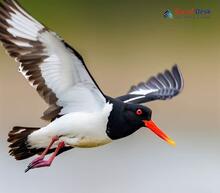The enthralling Haematopus genus, a group of birds known for their striking appearance and intriguing behavior, has captured the hearts of ornithologists and bird enthusiasts alike. In this blog post, let's take a closer look at these fascinating birds by exploring their history, classification, evolution, genetic relationships, species characteristics, and their rare sightings in Nepal.
Origin and History:
Part of the Haematopodidae family, the Haematopus genus includes birds commonly referred to as oystercatchers. You can spot these coastal creatures along shorelines across the globe. Their roots stretch back about 23 million years to the early Miocene epoch.
Taxonomy:
Comprising 11-12 distinct species, the Haematopus genus is also known as oystercatchers. While they may vary in size, color, and physical traits, they all share common features like strong bodies, long legs, sturdy beaks, and eye-catching plumage.
Evolutionary Development:
As oystercatchers evolved, they diversified to thrive in different coastal environments. This led to variations in their feeding habits and foraging strategies. Studying their evolutionary history offers important insights into how coastal bird populations have adapted to environmental changes over time.
Genetic Relationships:
Thanks to modern genetic research, we now have a better understanding of the intricate connections within the Haematopus genus. Some oystercatcher species may appear similar at first glance but examining their DNA uncovers significant genetic distinctions. These findings highlight how convergent evolution has shaped these birds' appearances across various regions around the world.
Species Traits:
Oystercatchers typically boast black or dark brown feathers with white undersides. Some even sport vibrant orange-red beaks and eyerings. They're known for their powerful beaks that enable them to feast on hard-shelled treats like mussels, oysters, and clams. Notably, oystercatchers are also famous for their monogamous mating habits and their territorial demeanor when it comes to safeguarding nesting sites.
Occurrence in Nepal:
Although Nepal isn't a typical habitat for the Haematopus genus, the Eurasian Oystercatcher (Haematopus ostralegus) has been occasionally spotted there during migration. This species visits wetlands and coastal areas in the southern Terai region, giving Nepali birdwatchers a rare opportunity to catch sight of these captivating creatures.
In conclusion, the Haematopus genus consists of an extraordinary group of birds that intrigue bird lovers with their stunning appearances and shed light on coastal evolution spanning millions of years. Preserving and protecting these remarkable coastal avians is vital, ensuring future generations can continue to learn from and admire them.




